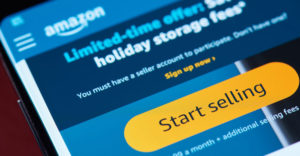The Amazon marketplace is an enticing option for many small and medium-sized businesses. With a massive consumer base, selling on Amazon can take a fledgling company to the next level, but it’s not without risks. By understanding the challenges, however, sellers can put themselves in the best position possible to capitalize on the opportunity of the Amazon platform.
Since its launch in 2007, Amazon has become an absolute juggernaut within the retail space, to the point where, in 2023, the business accounts for nearly 40% of the e-commerce market and a whopping $514 billion in revenue. As a business owner, you see those numbers and want a piece of the pie.
Amazon is also a unique entity within e-commerce, providing a platform for independent sellers who can choose to have their processing and shipping handled by Amazon or in-house. Around two million independent sellers on Amazon comprise roughly 60% of the sales on the platform — and of those two million, about 86% have their orders fulfilled by Amazon.
Still, with millions of sellers already on the platform and thousands more joining every week, it can be a challenge to stand out, not to mention the logistical problems that can arise from operating an Amazon store in addition to a brand’s dedicated e-commerce site.
There are best practices and rules of thumb that can help guide merchants to maximize the efficacy of their Amazon store. Here are some to keep in mind when getting started.
Build Your Amazon Product Pages for Maximum Impact
It’s important to remember that even though you’re selling through Amazon, it’s still your store. Everything on a product page should be clean, complete, and accurate.
It can be tempting to overload all of the above-the-fold space with as much information as possible, but keeping the bulleted section to short, descriptive sentences that convey essential information about the product will encourage customers to read and fully understand your offerings.
Merchants can use below-the-fold real estate to flesh out the product details fully while offering valuable space to sell the item. It can be challenging to strike a balance between too much content that shoppers can easily ignore and useful information that drives sales. Breaking up content with rich imagery can help keep the page engaging.
Product photos and videos are also essential and shouldn’t be shortchanged. Amazon has relatively strict image guidelines, but going above and beyond can help ensure accuracy and engagement. Be sure to get the highest resolution photography possible that best represents the product, particularly when it comes to different color variations.
While Amazon’s return rate sits between 5% and 15%, that rate is above 25% for clothing. For products where size and color are essential to buyers, ensure your imagery best represents your offerings to set customer expectations accordingly.
Additionally, leveraging A/B testing, or split testing, on your product pages is a powerful way to enhance sales. By comparing different page versions, you can see which elements — images, product descriptions, or call-to-action phrases — best engage customers and drive conversions. This targeted approach allows for fine-tuning your listings to boost both sales and customer satisfaction, thereby increasing your Amazon store’s competitiveness.
Focus on Content To Increase Discoverability
For Amazon, content is king. In a highly competitive marketplace, doing everything possible to make your products stand out is critical. Unlike your own e-commerce store, however, you’re limited by the structure of the Amazon product page. Getting creative with your copy and product imagery on the page can be a surefire way to stand out.
Getting a customer to the product page in the first place is a major challenge for sellers in competitive categories, however. Search engine optimization (SEO) plays a crucial role in clearing that hurdle for Amazon sellers.
When creating product names and descriptions, be sure to include as many descriptors as possible that convey what your product is and what it’s for. This practice can be difficult, particularly when it comes to balancing content for SEO without burying your brand.
We’ve all seen product names that are 40 words long and list every potential keyword for the item. Being intentional with the words you choose to describe your product while keeping your brand and product name at the forefront can enhance discoverability without sacrificing brand capital.
Regularly review and update your listings to ensure they align with current trends and Amazon’s algorithm changes. This proactive approach can enhance your product discoverability and competitive edge on the platform.
Understanding and optimizing for Amazon’s A9 algorithm — a system that ranks products based on relevance to customer searches and other factors — is also essential. Incorporate the most relevant keywords into your product listings in a natural and customer-friendly manner. This strategic approach can improve your products’ visibility and help align with Amazon’s goal of connecting customers with their most likely purchase products.
Integrating Amazon Into Your Omnichannel Strategy
Amazon is a great platform, but it’s not the only place your brand exists. As you build your product pages, make sure all information and creative assets are uniform across all platforms.
Having your Amazon product pages reflected on your e-commerce site and any other social selling platform or third-party seller helps increase your brand credibility and trustworthiness. Customers who search for your products and get five different sites telling them five different things are less likely to trust your brand.
Viewing Amazon as part of a broader omnichannel commerce experience is also essential for logistics and inventory management. Particularly for the majority of sellers who utilize Fulfillment by Amazon (FBA), it’s imperative to understand inventory levels at Amazon facilities.
Not only can low inventory lead to out-of-stock messaging in search results (another brand credibility issue), but you can also receive penalties from Amazon, including loss of search rank or buy box ranking and account suspension.
Foster Community Through Amazon
The true value of Amazon is that it’s a high-traffic, high-visibility platform. Even if margins may not be as lucrative as your own e-commerce store, the sales volume and brand awareness generated through Amazon can make it a worthwhile endeavor.
Amazon’s large audience can be an excellent tool for community and brand building; on Amazon, that community exists in the reviews. After a sale occurs, particularly early in your Amazon selling tenure, reach out to customers directly to encourage reviews and feedback.
The benefits of this engagement are twofold: First, it reminds customers to leave positive reviews, and second, it enables you to resolve any issues proactively and prevent the accumulation of negative reviews. Remember that adhering to Amazon’s guidelines on customer interaction is paramount to ensure compliance and maintain a positive seller standing.
The visibility that Amazon provides shines a spotlight on your brand. Going above and beyond in your customer service efforts and fully and politely addressing every concern demonstrates to potential customers that your brand truly cares.
Selling on Amazon can be a daunting proposition. However, aligning your Amazon presence to your overall brand messaging and focusing on the quality of your content can be a powerful sales tool that helps bring your brand to the next level.



















































Social Media
See all Social Media